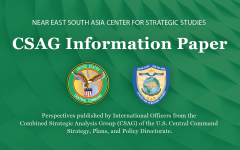CSAG Strategy Paper: Ceasefire Part 2 – Regional Escalation
January 31, 2025 2025-01-31 17:42CSAG Strategy Paper: Ceasefire Part 2 – Regional Escalation
CSAG Strategy Paper: Ceasefire Part 2 – Regional Escalation
CSAG STRATEGY PAPER
Ms. Sanna Stark (CF4), SWE Armed Forces (CSAG/CCJ5), COL Karim Ismail, EGY Armed Forces (CSAG/CCJ5), COL Jerzy Kania, POL Armed Forces (CSAG/CCJ5), MAJ Vasile Nodis, ROU Armed Forces (CSAG/CCJ5), LTC Mohammad Al-Hnaiti, JOR Armed Forces (CSAG/CCJ5), and LTC Ahmed Alzeyoudi, UAE Armed Forces (CSAG/CCJ5)
13 January 2025
Introduction:
Since the U.S., together with Egypt and Qatar, started pushing for a ceasefire deal in May 2024, there have been times when a comprehensive ceasefire deal appeared close. However, as the situation in the region has evolved, it is becoming clear that objective is likely far off.
The first paper in the CSAG Ceasefire-series was written to pinpoint how threat perceptions are affecting the prospects for a ceasefire amid the negotiations. While this second paper was intended to add dimensions important for breaking the cycle of violence, such as conflict ripeness, exit and negotiation strategies, and the impact of the mediators, the recent intense escalation in the region has added complexity, further affecting the potential for a ceasefire in Gaza. Therefore, this paper will address what the current state of the expanded regional, multiple front conflict means for a potential ceasefire in Gaza.
The conflict context expanded during the early fall of 2024 to include an escalating war between Israel and Hezbollah with increased consequences for the civilian populations in both Israel and Lebanon, and a further intensified direct conflict between Israel and Iran. In late November last year, a ceasefire deal was reached between Hezbollah and Israel, but the situation remains fragile with both sides violating the agreement. While it is important to focus on the broader escalation and its repercussions, it is crucial for future stability to not lose sight of what effects this has on the war in Gaza. Therefore, the question the CSAG is intending to answer in this paper is:
– How has the regional escalation affected the prospects for stabilizing the situation in Gaza and negotiating a ceasefire?
Key Points:
- The war in Gaza is and has been the ignition and enabler (and sometimes an excuse) for continued violence in the Middle East. Therefore, the U.S. and the international community should not lose sight of pushing a peaceful resolution for Gaza during the tensions in other operational areas.
- The security situation in the region is currently extremely volatile and could benefit great power competitors such as Russia and China.
- Continued escalation between Iran and Israel still carries an incalculable risk of having detrimental effects on the broader region and CENTCOM AOR.
- The scenario envisioned in the “General’s Plan” increases the risk for prolonged Israeli security control with continued suffering for the population in Gaza.
- In the mid to long-term, the war will likely also fuel further violence both in Gaza and the West Bank and create an increased base for recruitment to VEO’s.
- The U.S. should encourage Israel to clearly declare what the strategic objectives for Gaza are moving forward, as the international community is uncertain what Israel envisions in the longer term.
- Given the current ceasefire proposal for Gaza has not resulted in any success, it is possible it needs to be reframed to include smaller steps to be taken. The wait and see game increases the risk of extended reluctance to commit to a halt of hostilities.
View other USCENTCOM Combined Strategic Analysis Group (CSAG) papers here.
The opinions and conclusions expressed herein are those of a number of international officers within the Combined Strategic Analysis Group (CSAG) and do not necessarily reflect the views of United States Central Command, not of the nations represented within the CSAG or any other governmental agency.



